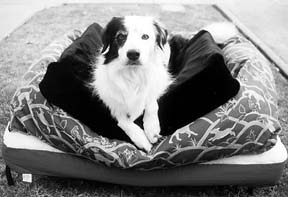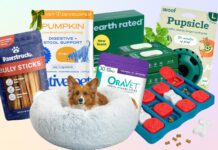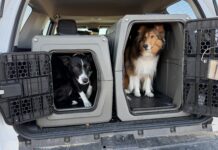We’ll admit it: We’ve been sleeping on the job. Our test dogs – and their test families – have been trying out dozens of beds, seeking to discover the qualities that contribute to a pooch’s good night’s sleep . . . and which construction details help us keep the beds clean and in one piece. We’ve identified a list of features that a good bed’s gotta have, and a few things that make some beds hard to live with.
We’ve also developed some favorite products. (You know a product is a winner when you can’t seem to get it back from the testers. “Well, how much IS that one? Maybe we could just keep it?”) Over the next few pages, we’ve pictured our top picks, and described what exactly it was about them that we (and our dogs!) liked so much. When one of our selections had faults, we discussed them, too; few things in life are perfect, but you alone are qualified to determine which flaws you are willing to live with.
We weren’t being egotistical when we had just one model (Rupert, our 10-year-old office dog/resident tester) pose on each of the beds for our photos. We thought it would be funny, plus, we rationalized, this way you would have some sense of scale, comparing the size of each bed with the same-sized dog. What that dog won’t do for the Whole Dog Journal! Thanks, Rupie.
Consider your dog, first
It goes without saying that before you select a bed, you have to know what sort of sleeping style is preferred by your dog. Does she like to stretch out in a flat sprawl? Curl up in a cozy ball? “Dig” and shape her nest? Be surrounded by a comforting wall? It’s no good buying a flat futon for the dog who likes to dig, or a dished-out nest for a sprawler; you’ll just see your money go to waste. Know your dog, keep the “princess and the pea” in mind, and buy accordingly.
Also, you might want to measure your dog before ordering. Some beds are available in only a few sizes, and you want to make sure that the one you order is not too small. “Not quite big enough” seemed to be one main reason our test dogs rejected certain models.
How to select a bed
The first rule of dog-bed buying is: don’t buy the cheapest beds. Shoddy workmanship, and paper-thin fabrics abound in the realm of inexpensive beds. This is one place where you definitely get what you pay for. Most dogs are fairly hard on their beds – scratching and digging at the fabric, and maybe, taking an occasional nibble. Plus, you just have to wash these things fairly frequently, so the fabric has to be able to hold up. Don’t skimp; you’ll regret it after the third washing.
Speaking of washing, if you’re battling a flea problem, you have to wash your dog’s bed at least once a week, cover and all. Water kills flea eggs, which fleas habitually lay in the dog’s bed. It’s no good washing only the cover; these tiny specks can sink right into foam rubber and through seams. So, to fight fleas, choose a bed that can be dried, so you will wash it as frequently as you need to, without putting Fido out for the night. In our estimation, a bed must also offer the following:
• Covers that are easy to take off and put on after washing. Sincerely, we’ve known beds that literally had us in tears, trying to get the covers back on. Look for beds with covers that have the zippers on the long sides.
• Ability to replace or refill the stuffing. Many dog beds are stuffed with polyester filling, sometimes supplemented by cedar shavings or other loose material. With these beds, which are frequently popular with dogs who like to nest, the inner pillow should always have a zipper or other closure, enabling you to replace or refresh the stuffing when it gets compressed.
• Quality foam (in foam beds). Most beds deemed “orthopedic” are made with eggcrate foam inside, but the quality, density, and thickness of this foam varies a LOT. Many beds dubbed “orthopedic,” we found, had foam so thin that we could squish it between our fingers to paper thinness. What’s that going to do for an arthritic dog? The manufacturers that label these products thusly should have to sleep on them for the rest of their lives! If you decide to buy an orthopedic bed, look for one with the thickest, most dense foam available; it has to be thick enough that your dog’s weight doesn’t crush the foam to the floor.
• Cedar for just those dogs that like it. You can’t assume, just because a catalog tells you it’s true, that your dog is going to love the cedar scent; some dogs hate the scent. Cedar was first introduced to dog beds for its reputed ability to repel fleas, and to cover doggie odors.
We’ll just say this: If your dog has fleas, cedar won’t make them go away. And if your dog smells, give him a bath, and consult your holistic veterinarian! A healthy dog should smell good; if he doesn’t, something is wrong. (Why should a dog be any different from a person? If someone you knew smelled terrible, you’d automatically think they had an endocrine disorder or something. The same goes for dogs.)
• Ability to be returned. Sometimes, no matter what, our dogs just don’t like what we buy. That’s a dog’s preogative. Place your dog’s new bed on a clean sheet, and cover it with another one for the first few days. If you don’t find your dog snoozing on the bed every morning, uncover it, brush it off, send it back, and try again.
• Attractiveness. You’ll note that this is last on our list; “matching the decor” is no reason to buy, just a nice bonus. Nor is the bed’s resemblance to Cleopatra’s velvet couch, or other nonsense. When people choose dog gear based on that criteria, they get what they deserve: a big credit card bill, an untouched dog bed, and a dog who sleeps on their bed. Wait a second, that last one is not so bad, after all! But it does defeat the purpose . . .
-By Nancy Kerns







Yeah is very hard to do any returns in same beds and sometimes and sometimes you have to pay for the returning label..
Why can I not access the list of beds? The article says:
“Over the next few pages, we’ve pictured our top picks, and described what exactly it was about them that we (and our dogs!) liked so much. When one of our selections had faults, we discussed them, too; few things in life are perfect, but you alone are qualified to determine which flaws you are willing to live with.”